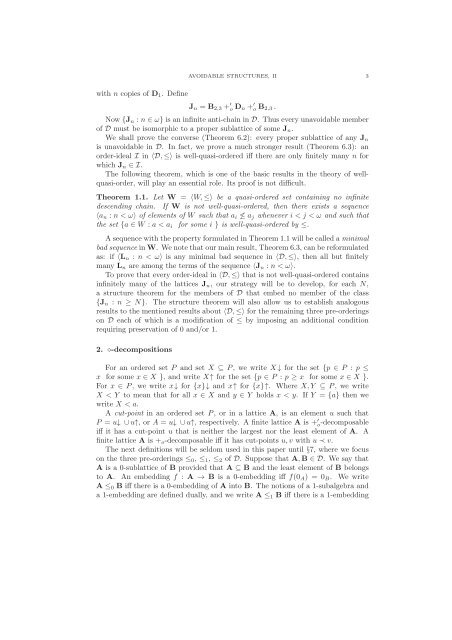Avoidable structures, II: finite distributive lattices and nicely ...
Avoidable structures, II: finite distributive lattices and nicely ...
Avoidable structures, II: finite distributive lattices and nicely ...
Create successful ePaper yourself
Turn your PDF publications into a flip-book with our unique Google optimized e-Paper software.
AVOIDABLE STRUCTURES, <strong>II</strong> 3<br />
with n copies of D 1 . Define<br />
J n = B 2,3 + ′ o D n + ′ o B 2,3 .<br />
Now {J n : n ∈ ω} is an in<strong>finite</strong> anti-chain in D. Thus every unavoidable member<br />
of D must be isomorphic to a proper sublattice of some J n .<br />
We shall prove the converse (Theorem 6.2): every proper sublattice of any J n<br />
is unavoidable in D. In fact, we prove a much stronger result (Theorem 6.3): an<br />
order-ideal I in 〈D,≤〉 is well-quasi-ordered iff there are only <strong>finite</strong>ly many n for<br />
which J n ∈ I.<br />
The following theorem, which is one of the basic results in the theory of wellquasi-order,<br />
will play an essential role. Its proof is not difficult.<br />
Theorem 1.1. Let W = 〈W,≤〉 be a quasi-ordered set containing no in<strong>finite</strong><br />
descending chain. If W is not well-quasi-ordered, then there exists a sequence<br />
〈a n : n < ω〉 of elements of W such that a i ≰ a j whenever i < j < ω <strong>and</strong> such that<br />
the set {a ∈ W : a < a i for some i } is well-quasi-ordered by ≤.<br />
A sequence with the property formulated in Theorem 1.1 will be called a minimal<br />
bad sequenceinW. Wenotethatourmainresult, Theorem6.3, canbereformulated<br />
as: if 〈L n : n < ω〉 is any minimal bad sequence in 〈D,≤〉, then all but <strong>finite</strong>ly<br />
many L n are among the terms of the sequence 〈J n : n < ω〉.<br />
To prove that every order-ideal in 〈D,≤〉 that is not well-quasi-ordered contains<br />
in<strong>finite</strong>ly many of the <strong>lattices</strong> J n , our strategy will be to develop, for each N,<br />
a structure theorem for the members of D that embed no member of the class<br />
{J n : n ≥ N}. The structure theorem will also allow us to establish analogous<br />
results to the mentioned results about 〈D,≤〉 for the remaining three pre-orderings<br />
on D each of which is a modification of ≤ by imposing an additional condition<br />
requiring preservation of 0 <strong>and</strong>/or 1.<br />
2. ⋄-decompositions<br />
For an ordered set P <strong>and</strong> set X ⊆ P, we write X↓ for the set {p ∈ P : p ≤<br />
x for some x ∈ X }, <strong>and</strong> write X↑ for the set {p ∈ P : p ≥ x for some x ∈ X }.<br />
For x ∈ P, we write x↓ for {x}↓ <strong>and</strong> x↑ for {x}↑. Where X,Y ⊆ P, we write<br />
X < Y to mean that for all x ∈ X <strong>and</strong> y ∈ Y holds x < y. If Y = {a} then we<br />
write X < a.<br />
A cut-point in an ordered set P, or in a lattice A, is an element u such that<br />
P = u↓ ∪u↑, or A = u↓ ∪u↑, respectively. A <strong>finite</strong> lattice A is + ′ o-decomposable<br />
iff it has a cut-point u that is neither the largest nor the least element of A. A<br />
<strong>finite</strong> lattice A is + o -decomposable iff it has cut-points u,v with u ≺ v.<br />
The next definitions will be seldom used in this paper until §7, where we focus<br />
on the three pre-orderings ≤ 0 , ≤ 1 , ≤ 2 of D. Suppose that A,B ∈ D. We say that<br />
A is a 0-sublattice of B provided that A ⊆ B <strong>and</strong> the least element of B belongs<br />
to A. An embedding f : A → B is a 0-embedding iff f(0 A ) = 0 B . We write<br />
A ≤ 0 B iff there is a 0-embedding of A into B. The notions of a 1-subalgebra <strong>and</strong><br />
a 1-embedding are defined dually, <strong>and</strong> we write A ≤ 1 B iff there is a 1-embedding
















